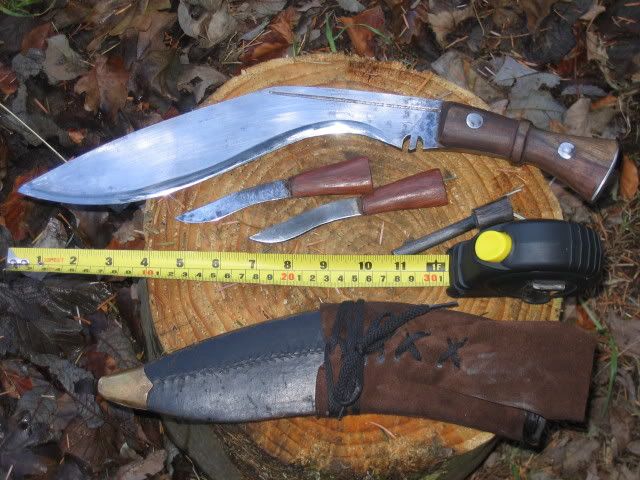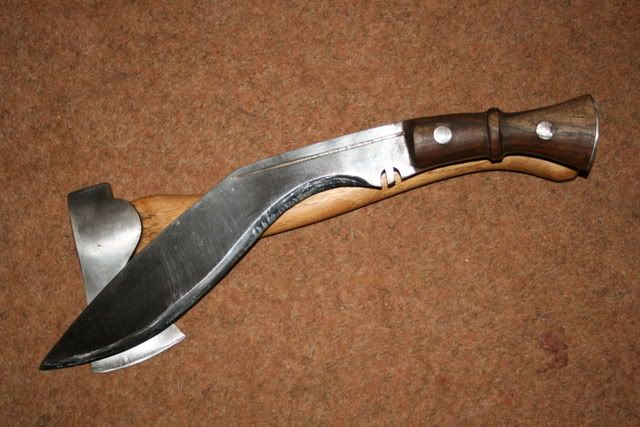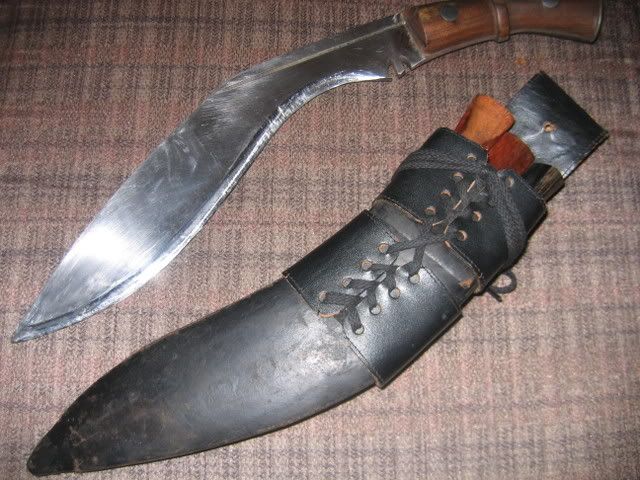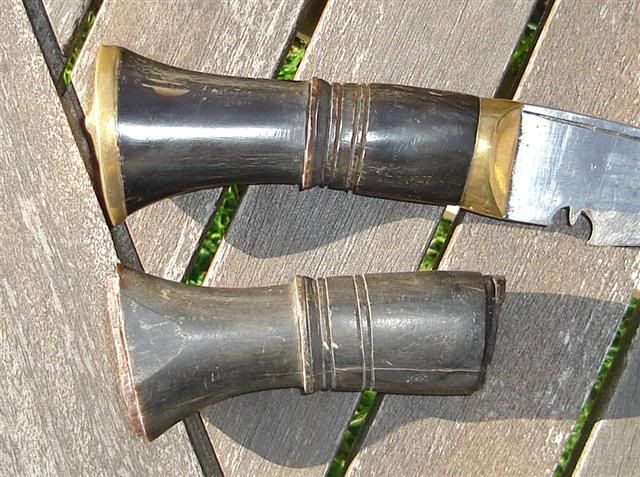Kukri Project
Copied from British Blades ..
The creation of this thread is my side of a bargain I struck with Rob RCS in return for a kukri sent free of financial cost to myself.
For a long time I had been an advocate of big knife = wrong, without really understanding the implications of my blinkered view. A few months ago I tried to cheapskate my way around this by making a huge cudgel of a thing loosely based on a Tom Brown Tracker the resulting behemoth coming in at near two pounds in weight and about as much use in cutting as a crow bar. So, to try to redress this unbalanced view of large knives, I thought to take the kukri track them not being too prohibitively expensive and widely known because of their Ghurkha owners and distinctive profile. What I hadnt bargained upon was loosing my job in October which kind of put a block on any potential purchases until my deal on here came up trumps as mentioned in the opening line.
Im sure I wont be the only person on this forum to have seen Dave Canterburys Pathfinder website and forum and the development of his Pathfinder knife with huge kukri overtones. I had an idea that I could modify something along similar lines that would become a compliment to my existing Bushcraft set-up of home-made Woody clone knife, folding saw and axe.
Some of the things I had thought about changing were as follows:-
Handle Rubber grips to aid wet weather use and maybe a total redesign.
Blade - Multi profile edge for multiple uses along the blade length.
Sheath Material and layout. Locking mechanism for blade?
Mountable on shoulder strap of rucksack?, Blade to remain secure when inverted.
Horizontal carry, Flat or Scout style.
The item that turned up in the post is stunning, good quality, solid and strong. The sheath was missing a belt loop but otherwise complete. There seems to be two Kharda instead of one and a Chakmak, both items are near identical and both have a profiled edges. There is a small space in the side of the sheath which I have filled with a fire-steel.
As for first jobs, I treated the sheath with Neatsfoot oil and polish and sprayed WD40 into the inner surface to soak into the wood and augment corrosion resistance. I have stripped the varnished finish off the handle and oiled the wood and Im much happier with the feel in the hand, though it might yet prove to be too smooth and need a rougher finish to keep it secure in the hand.
I have also lengthened the cutting edge by gentle grinding inside the inner curve back towards the handle. This has resulted in about 3 extra inches of useable cutting edge that can be used for chopping close to the handle, or more importantly as a draw knife with the non-knife hand holding the blade towards the tip.
Lets start with what I found to be right about the Ghurkha Kukri.
Well for starters, it has been around for a hundred years or more in much the same as its present guise and that alone implies that there cant be a huge amount wrong with the basic design. It is without doubt, that the geometry and weight forward design combine to give this versatile tool its advantages, handling in part like an axe for chopping but with an edge that promotes a slicing motion there are probably few improvements that can be made other than minor tweaks and different materials.
One thing I owed the designers of such an impressive tool was to get used to the way it behaved before thinking about what improvements I could make on a personal level. The double opposed conical handle with raised centre collar looks a lot more uncomfortable than it is in actuality. I think it leads to a very secure grip, encouraging each finger to perform a recognisable function in contributing to the overall grip. Little and third fingers secure the grip against the heavy blade moving forwards which was my initial concern with such a heavy thing. The collar locks between middle & third fingers, providing a surprisingly effective solid hold. Index and middle fingers close around the reversed cone at the front of the handle and give very accurate aim and guidance to the blade in motion. Furthermore, the handle can be displaced forward by one or two fingers with no loss of that secure feeling and gaining up to extra two inches in effective length when swinging the knife lekku style.
While I cannot claim to have used this blade heavily, I have tried some fire wood chopping & splitting, some clearing of vegetation and branches and such. At each point I tried to imagine how my perceived improvements would affect the handling or aesthetics of the knife . Sad to say that at every stage my ideas were blown out of the water; handle mods, sheath mods, anything to do with handling, carrying or any extras; its all perfect just as it is. I feel such a fraud now after blagging it for free, but its going to take much more skilled blade-smith than I to make any significant improvement over the original equipment.
So what can I do to improve it?
The mods I want to consider are in fitting it to my hand and something around the sheath, hence my thoughts earlier.
The Sheath is covered in supposed goat skin (though it could well be buffalo hide depending upon the source you read). It is acceptably strong for its intended task, but missing any form of belt loop, though this was soon remedied after a trip to a charity shop and the purchase of a second hand leather belt and a short time cutting and stitching.
As for the various methods of carrying the sheath, once again the original shines through as the tried and tested best. If I was to try to carry it Scout style (horizontal across the small of the back) it would have to be with the handle down which drops the knife into the locked position in the scabbard, but a jolt might loosen the blade and have it shaking loose and falling down the back of your leg. To carry it edge up would go all against the advice of not clasping the scabbard to withdraw the edge risking it cutting through the sheath and endangering the holding fingers. The advised method of side or rear carry means that the sheath is naturally supported by the non-knife hand, around the spine of the blade keeping things just about as safe as they can be.
Sharpening might take a little practice, Ive tried a few options with varying success, but I think Ill stick with simple ceramic stones which give a pleasing finish when used free-hand then do a final polish on a leather strop, though it really isnt necessary.
In closing, and I am aware that I havent handled many large knives, but this kukri is about as good as a large knife gets for the tasks that I have so far put in front of it.
I have to extend my deepest thanks for the offers of kindness when I posted my original query and to Rob RCS in particular, who deserves medals for his benevolence.
Now some quick piccies .
Within a few days of arrival, with a very temporary belt loop and the firesteel.

One to show the curious alignment of cutting edge and handle compared to a Cegga axe.

And as it appears most recently with a belt loop created from a recycled leather belt.

All the best
Ogri the trog
Copied from British Blades ..
The creation of this thread is my side of a bargain I struck with Rob RCS in return for a kukri sent free of financial cost to myself.
For a long time I had been an advocate of big knife = wrong, without really understanding the implications of my blinkered view. A few months ago I tried to cheapskate my way around this by making a huge cudgel of a thing loosely based on a Tom Brown Tracker the resulting behemoth coming in at near two pounds in weight and about as much use in cutting as a crow bar. So, to try to redress this unbalanced view of large knives, I thought to take the kukri track them not being too prohibitively expensive and widely known because of their Ghurkha owners and distinctive profile. What I hadnt bargained upon was loosing my job in October which kind of put a block on any potential purchases until my deal on here came up trumps as mentioned in the opening line.
Im sure I wont be the only person on this forum to have seen Dave Canterburys Pathfinder website and forum and the development of his Pathfinder knife with huge kukri overtones. I had an idea that I could modify something along similar lines that would become a compliment to my existing Bushcraft set-up of home-made Woody clone knife, folding saw and axe.
Some of the things I had thought about changing were as follows:-
Handle Rubber grips to aid wet weather use and maybe a total redesign.
Blade - Multi profile edge for multiple uses along the blade length.
Sheath Material and layout. Locking mechanism for blade?
Mountable on shoulder strap of rucksack?, Blade to remain secure when inverted.
Horizontal carry, Flat or Scout style.
The item that turned up in the post is stunning, good quality, solid and strong. The sheath was missing a belt loop but otherwise complete. There seems to be two Kharda instead of one and a Chakmak, both items are near identical and both have a profiled edges. There is a small space in the side of the sheath which I have filled with a fire-steel.
As for first jobs, I treated the sheath with Neatsfoot oil and polish and sprayed WD40 into the inner surface to soak into the wood and augment corrosion resistance. I have stripped the varnished finish off the handle and oiled the wood and Im much happier with the feel in the hand, though it might yet prove to be too smooth and need a rougher finish to keep it secure in the hand.
I have also lengthened the cutting edge by gentle grinding inside the inner curve back towards the handle. This has resulted in about 3 extra inches of useable cutting edge that can be used for chopping close to the handle, or more importantly as a draw knife with the non-knife hand holding the blade towards the tip.
Lets start with what I found to be right about the Ghurkha Kukri.
Well for starters, it has been around for a hundred years or more in much the same as its present guise and that alone implies that there cant be a huge amount wrong with the basic design. It is without doubt, that the geometry and weight forward design combine to give this versatile tool its advantages, handling in part like an axe for chopping but with an edge that promotes a slicing motion there are probably few improvements that can be made other than minor tweaks and different materials.
One thing I owed the designers of such an impressive tool was to get used to the way it behaved before thinking about what improvements I could make on a personal level. The double opposed conical handle with raised centre collar looks a lot more uncomfortable than it is in actuality. I think it leads to a very secure grip, encouraging each finger to perform a recognisable function in contributing to the overall grip. Little and third fingers secure the grip against the heavy blade moving forwards which was my initial concern with such a heavy thing. The collar locks between middle & third fingers, providing a surprisingly effective solid hold. Index and middle fingers close around the reversed cone at the front of the handle and give very accurate aim and guidance to the blade in motion. Furthermore, the handle can be displaced forward by one or two fingers with no loss of that secure feeling and gaining up to extra two inches in effective length when swinging the knife lekku style.
While I cannot claim to have used this blade heavily, I have tried some fire wood chopping & splitting, some clearing of vegetation and branches and such. At each point I tried to imagine how my perceived improvements would affect the handling or aesthetics of the knife . Sad to say that at every stage my ideas were blown out of the water; handle mods, sheath mods, anything to do with handling, carrying or any extras; its all perfect just as it is. I feel such a fraud now after blagging it for free, but its going to take much more skilled blade-smith than I to make any significant improvement over the original equipment.
So what can I do to improve it?
The mods I want to consider are in fitting it to my hand and something around the sheath, hence my thoughts earlier.
The Sheath is covered in supposed goat skin (though it could well be buffalo hide depending upon the source you read). It is acceptably strong for its intended task, but missing any form of belt loop, though this was soon remedied after a trip to a charity shop and the purchase of a second hand leather belt and a short time cutting and stitching.
As for the various methods of carrying the sheath, once again the original shines through as the tried and tested best. If I was to try to carry it Scout style (horizontal across the small of the back) it would have to be with the handle down which drops the knife into the locked position in the scabbard, but a jolt might loosen the blade and have it shaking loose and falling down the back of your leg. To carry it edge up would go all against the advice of not clasping the scabbard to withdraw the edge risking it cutting through the sheath and endangering the holding fingers. The advised method of side or rear carry means that the sheath is naturally supported by the non-knife hand, around the spine of the blade keeping things just about as safe as they can be.
Sharpening might take a little practice, Ive tried a few options with varying success, but I think Ill stick with simple ceramic stones which give a pleasing finish when used free-hand then do a final polish on a leather strop, though it really isnt necessary.
In closing, and I am aware that I havent handled many large knives, but this kukri is about as good as a large knife gets for the tasks that I have so far put in front of it.
I have to extend my deepest thanks for the offers of kindness when I posted my original query and to Rob RCS in particular, who deserves medals for his benevolence.
Now some quick piccies .
Within a few days of arrival, with a very temporary belt loop and the firesteel.

One to show the curious alignment of cutting edge and handle compared to a Cegga axe.

And as it appears most recently with a belt loop created from a recycled leather belt.

All the best
Ogri the trog

